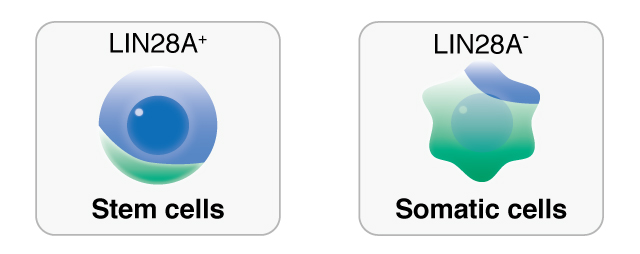
Research Activities
Research Activities
Publications
May 19, 2017
Synthetic RNA to detect proteins and select stem cells

RNA technology made at CiRA varies cell fluorescence
based on the expression of specific proteins.
A major goal of synthetic biology is the manipulation of cell behavior by detecting specific cell signals and molecules like proteins.
There already exist many techniques that achieve these goals, but as CiRA Professor and bioengineer Hirohide Saito explains, "Many gene circuits depend on adding foreign DNA to the cell, which risks mutating the cell."
As an alternative, Saito has been investigating RNA, which unlike DNA, has a short lifetime and does not enter the cell nucleus, where mutations may occur. In the latest work from his lab, his group shows how an RNA-based device can respond to the expression of a protein associated with stemness, LIN28A. The device was used to separate stem cells from non-stem cells, a necessary step for any stem cell-based medical therapy.
Saito chose LIN28A because of its function in cellular reprogramming.
"LIN28A has an important role in self-renewal. It is a good protein to choose if you want to target pluripotent stem cells, such as human iPS cells," he said.
"Aptamers" describe RNA sequences that bind to target ligands such as proteins and are used by bioengineers to control cellular behavior. Natural aptamers for Lin28A are known, but the protein binding ability is too weak for Saito's aims.
To enhance the binding, Shunsuke Kawasaki, who recently graduated from the Saito lab, engineered synthetic LIN28A-binding RNA devices that function in cells.
"We wanted to stabilize the secondary structure by increasing the number of GC pairs in the stem region, while at the same time not compromising the portion responsible for Lin28A binding," he said.
The modified aptamer was the basis for a new device that controlled gene expressions inside cells in response to the amount of LIN28A. In addition, Kawasaki and Saito could deliver the device into living cells, making both the device and delivery an all RNA system. Using this new RNA device, they succeeded in distinguishing iPS cells from differentiated cells.
"Because our device is all RNA and because our delivery method is all RNA, it may be safe for use in humans," said Saito.
Paper Details
- Journal: Nucleic Acids Research
- Title: Synthetic mRNA devices that detect endogenous proteins and distinguish mammalian cells
- Authors: Kawasaki S1,2, Fujita Y2, Nagaike T3, Tomita K3, and Saito H2
- Author Affiliations:
- Graduate School of Medicine, Kyoto University, Kyoto, Japan
- Center for iPS Cell Research and Application (CiRA), Kyoto University, Kyoto, Japan
- Graduate School of Frontier Science, Tokyo University, Chiba, Japan






















